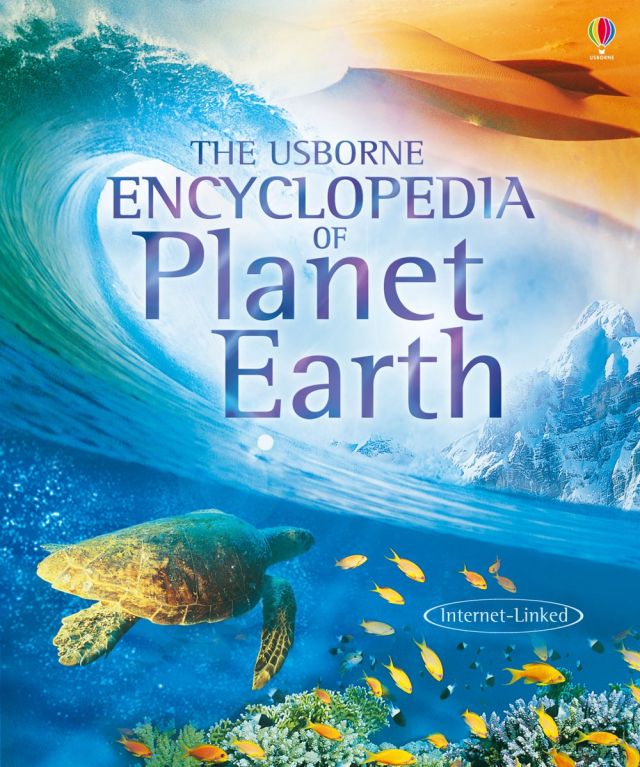You've added:
The Usborne Encyclopedia of Planet EarthThe Usborne Encyclopedia of Planet Earth
Age 8+
Buy from:
A comprehensive introduction to physical geography including information on the climate, volcanoes, erosion, the weather, ecosystems and humans. Fabulously illustrated with photographs, maps, diagrams and illustrations that will capture the imagination of young readers. Includes an extensive glossary, fact finder and world records. With internet links to recommended websites with maps, quizzes, games and homework information. The material in this book is also available as part of the Usborne Geography Encyclopedia.
Chapters in this book include:
Planet Earth
-The Earth in Space
-Looking at the Earth
-The Seasons
-Day and Night
-Inside the Earth
-The Earth's Crust
-Rocks, Minerals and Fossils
-The Eearth's Resources
-Energy from Earth
Earthquakes and Volcanoes
-The Exploding Earth
-Volcanic Variations
-Natural Hot Water
-Volcanic Islands
-Living with Volcanoes
-Earthquake Effects
-How Earthquakes Happen
-Earthquake Safety
-Giant Waves
Climate
-The Earth's Atmosphere
-Airt and Ocean Currents
-Natural Cycles
-Global Warming
-Rainforests
-Tropical Grasslands
-Monsoons
-Tropical Deserts
-Mediterranea Climates
-Temperate Climates
-Polar Regions
-Mountains
-Changing Climates
Weather
-What is Weather?
-Water and Clouds
-Thunderstorms
-Windstorms
-Floods and Droughts
-Freezing an Frying
-Strange Weather
-Weather Forecasting
Plants and Animals
-Plant Life on Earth
-Animal Life on Earth
-Ecosystems
-Population
-Farming
-Farming Methods
Shaping the Land
-Soil
-Looking after Soil
-Weathering
-Erosion
Rivers and Oceans
-Rivers
-River Erosion
-Water in the Ground
-Rivers of Ice
-The Edge of the sea
-Seas and Oceans
-Using Seas and Oceans
Useful Information
-Glossary
-Maps and Lines
-The Earth's Cycles
-Sciences and Scientists
-World Records
-Measurements
- Extent:
- 160 pages
- Dimensions:
- 276 x 216mm
- Paperback ISBN:
- 9781409566243
- Key Stage:
- KS2
- Publication Date:
- July 2013
- Work Reference:
- 01252
Chapters in this book include:
Planet Earth
-The Earth in Space
-Looking at the Earth
-The Seasons
-Day and Night
-Inside the Earth
-The Earth's Crust
-Rocks, Minerals and Fossils
-The Eearth's Resources
-Energy from Earth
Earthquakes and Volcanoes
-The Exploding Earth
-Volcanic Variations
-Natural Hot Water
-Volcanic Islands
-Living with Volcanoes
-Earthquake Effects
-How Earthquakes Happen
-Earthquake Safety
-Giant Waves
Climate
-The Earth's Atmosphere
-Airt and Ocean Currents
-Natural Cycles
-Global Warming
-Rainforests
-Tropical Grasslands
-Monsoons
-Tropical Deserts
-Mediterranea Climates
-Temperate Climates
-Polar Regions
-Mountains
-Changing Climates
Weather
-What is Weather?
-Water and Clouds
-Thunderstorms
-Windstorms
-Floods and Droughts
-Freezing an Frying
-Strange Weather
-Weather Forecasting
Plants and Animals
-Plant Life on Earth
-Animal Life on Earth
-Ecosystems
-Population
-Farming
-Farming Methods
Shaping the Land
-Soil
-Looking after Soil
-Weathering
-Erosion
Rivers and Oceans
-Rivers
-River Erosion
-Water in the Ground
-Rivers of Ice
-The Edge of the sea
-Seas and Oceans
-Using Seas and Oceans
Useful Information
-Glossary
-Maps and Lines
-The Earth's Cycles
-Sciences and Scientists
-World Records
-Measurements
View series: Usborne Encyclopedias
Quicklinks
Visit Usborne Quicklinks for links to websites where you can find videos, quizzes and fascinating facts about planet Earth.






